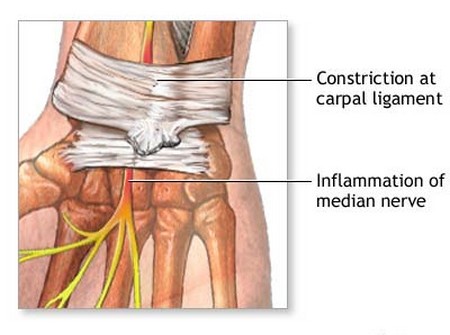What do typists, meat cutters, jack hammer operators, computer operators, and sign language interpreters have in common? They sound like a pretty diverse group, but they’re all alike in at least one way. They are at greater risk for developing carpal tunnel syndrome.
This condition mainly affects people whose work requires repeated motions with the hands and wrists. You don’t have to be in one of the above professions to be affected, though. Many activities can cause it, even enjoyable ones like needlework or playing the piano or guitar. Occasionally, it occurs for no apparent reason.

You have several nerves which allow you to move and feel your hands and fingers. One of them — the median nerve — runs through an area in your wrist called the carpal tunnel. Tendons, which connect your muscles and bones, also pass through this tunnel. If you overuse these tendons, they may swell and press on the median nerve. Since that nerve controls feeling and movement in your hand, the result will be pain, numbness, or tingling throughout your hand and wrist.
Anti-inflammatories like ibuprofen may give you short-term relief. If your pain persists, your doctor may recommend shots of corticosteroids.
The long-range plan for carpal tunnel syndrome
Though your kids may accuse you of living in the Stone Age, there’s really no doubt you are living in the Information Age. Computers are now an important part of modern life. Simply click on the Internet, and you can find all types of information, chat with people thousands of miles away, play games, and even shop. But does all this convenience come with a price? Can “surfing the net” be hazardous to your health?

Unfortunately, it might. The more we use computers, the more we develop stress injuries like carpal tunnel syndrome. Carpal tunnel is not a new disorder — it was once called the illness of knitters. Today, however, it is more likely to be chalked up to the hazards of computer use. But if you are a typist, computer operator, or dedicated net surfer, don’t despair. You can take steps to protect your hands from this painful, numbing condition.
- Sit correctly. “Sit up straight! Don’t slouch,” your mother used to tell you. Mom was right once again. Sitting incorrectly can lead to carpal tunnel and other problems, especially if you’re in front of a keyboard all day long. Make sure your chair and keyboard are at a comfortable height for you, and don’t slump over. Sit up straight or lean back slightly.
- Straighten your wrists. If you work at a keyboard, don’t rest your wrists on your desk. When you do this, you bend your wrists upward, which increases your risk of carpal tunnel. If you have a problem holding your wrists straight, buy specially made wrist rests for your keyboard.
- Brace yourself. Wearing a wrist brace may help keep your wrists straight so they don’t put constant pressure on your median nerve. If this interferes with your work, try wearing the brace only at night, which is when much of the pain occurs anyway.
- Take a break. If you are doing anything that requires repeated hand movements, take a break every hour or so. Do something different for a few minutes to relieve the stress on your hands.
- Shake it out. Some people find temporary relief by shaking or rubbing their hands. If your pain occurs at night, try hanging your hands over the side of the bed while you sleep.

- Beware of B6. Some health professionals believe a vitamin B6 deficiency may cause carpal tunnel syndrome. However, a recent study found no connection, and large doses of B6 can cause permanent nerve damage. Make sure you get enough vitamins, but be careful if someone recommends megadoses of B6 for this condition.
- Lighten up. If you are overweight, you are at greater risk for carpal tunnel. Losing weight will help your hands, your heart, and your overall health.
It’s also very important to get your hands, fingers, and wrists checked out by a professional physician so they can diagnose your case properly and distinguish it from other muscle, joint, nerve diseases. One of the most common diseases that can be mistaken for Carpal Tunnel Syndrome is Dupuytren’s Disease. In this disease, the fascia fibers under your palms start to thicken and contract, causing knots in your fascia that can pull your fingers inwards. Dupuytrens Symptoms are major discomfort, movement restrictions, and even pain in some cases. In cases like these, it’s important to get it checked by your doctor as soon as possible so they can give you the proper Dupuytrens treatment.
If these suggestions don’t help, discuss your condition with your doctor. He may recommend surgery to relieve pressure on the median nerve. But don’t put it off, hoping the problem will go away. Without treatment, your nerve damage, along with your painful symptoms, may become permanent.